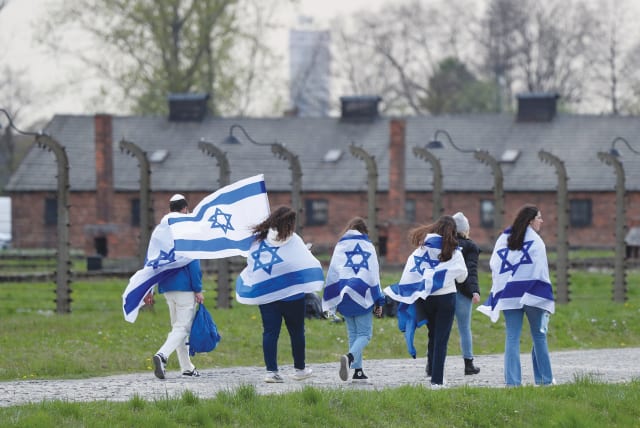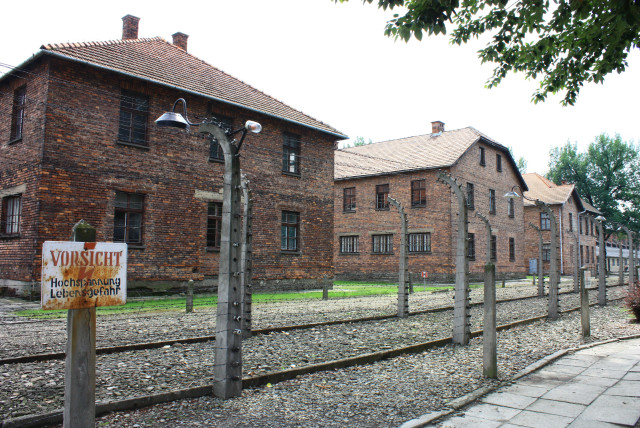Grapevine: Unconventional documentary

Movers and shakers in Israeli society.
Poland and Israel recently concluded an agreement that enables the resumption of Israeli student trips to Poland. These trips are geared to imbuing Holocaust awareness. Not all parents can afford to pay for them, and not all parents want their children to be exposed to the horrors of yesteryear. In addition there are certain haredi schools in which the Holocaust does not feature anywhere on the curriculum, and students in those schools simply don’t go to Poland – not on a student trip and not for a March of the Living.
Of course, there are haredi schools whose principals think it’s important for their students to learn firsthand about the Holocaust – but the majority don’t.
Miriam Cohen, a haredi film director and actress, went to one of the schools that didn’t. It had always pained the Canadian-born young woman that she had been unable to go as a schoolgirl, and she felt for others who were in a similar position. And then she met haredi film producer Chani Kopilowitz, who had also missed out on going to Poland, and the two decided to make a film for all those who might never set foot on Polish soil, but who craved more familiarity with Holocaust history. They approached many people both for seed money and technological know-how and were rebuffed time and again. But they never lost sight of their goal.
An additional obstacle to the realization of their dream was the pandemic, when travel abroad became extremely limited both in terms of leaving one’s own country and in landing in another.
They purchased their own VR camera, somehow got out of Israel and criss-crossed Europe in a series of connections till they eventually got to Poland.
They did not want to make the conventional documentary. They wanted viewers to feel as though they had actually been there. To facilitate this, they enlisted the help of Gerrer Hassid, Rabbi Israel Goldwasser, who is a natural born storyteller, an expert on the Holocaust and the grandson of Holocaust survivors. Goldwasser grew up hearing stories about the triumph of the Jewish spirit, of how people risked death because of faith, were saved from death because of faith and went to their deaths with the Shema on their lips.
I have been to Auschwitz seven times – six as part of a group, which meant we got through in a limited time and barely had a chance to stop and look at anything, and once on my own, to personally mourn my paternal grandfather, an Aleksander Hassid, whose life came to end in this place, and where I did a lot of exploring. But I didn’t see some of what is shown in the VR movie under the title 360 degrees in Auschwitz. The VR headset enables viewers to see the whole panorama, and not just what is directly in front of them.
Goldwasser, dressed in his hassidic garb, takes viewers first to Krakow, the seat of so much Polish-Jewish history and religious tradition. Fortunately, Krakow suffered little damage from the Nazis, and the ancient synagogues are still standing intact, and the stained glass windows in one of the synagogues remained unbroken in all their glory.
Travel time from Krakow to Auschwitz is roughly one-and-a-half hours.
Goldwasser takes the viewer inside the gate where the sign Arbeit Macht Frei continues to deceive. So many hundreds of thousands of people – not only Jews – thought they were coming to a labor camp. Some were dead within an hour of their arrival.
At a sealed cattle car which once brought Jews to Auschwitz, Goldwasser tells of a very religious Jew who never went anywhere without his tallit and tefillin. But as everyone was made to get out of the cattle car, they left their belongings behind. The religious Jew had gone only a few steps, when he realized that he was without the small bag in which he carried his tallit and tefillin. He turned back, and the Nazi guard yelled at him to keep going. The man protested that he never went anywhere without his tallit and tefillin, and kept walking toward the cattle car. The Nazi guard shot him in the head and he died instantly. After the war, the man’s son became affluent and spent a fortune tracing the cattle car, which now stands locked in Auschwitz with a tallit and tefillin inside.
After telling this story, Goldwasser wrapped himself in a tallit and began walking along the long railway line into the distance – a sole Jewish figure in the striped and fringed prayer shawl which Jews usually don for the first time at their bar mitzvah, and again at their wedding and then permanently at prayer and at synagogue services for the rest of their lives. They are wrapped in it when they die and are buried. This lone Jew in the snow-white tallit, walking the length of an otherwise empty Auschwitz, is arguably one of the most powerful scenes in the movie.
In the movie, viewers who may have been to Auschwitz are taken to a lot of places that they did not see, or that were not explained to them when they visited.
The film, which lasts for approximately an hour, is available in English and Hebrew versions. It can be seen in institutions, offices and other places, or in the basement of the indoor Mamilla Mall, where a large number of people can be accommodated. In Mamilla it can be seen in the evenings on Sunday to Thursday inclusive and on Friday mornings from 9 a.m., with the final showing at 12:30 p.m.
Though made by haredim and initially for haredim, the film has been shown to secular and non-Jewish audiences, and it includes references to secular and non-Jewish victims of the Holocaust. It finishes at the Western Wall in Jerusalem, at the induction ceremony for soldiers, the inauguration of a Torah scroll and the Hoshana Raba prayer service.
Not all haredim serve in the IDF, but they appreciate the fact that the Jewish people today has an army that can defend them.
Further details are available at jvr360.co.io and on Facebook
A surprise right before your eyes
■ SOMETIMES WE don’t see things that are right in front of us. Naomi Leibler, honorary president of World Emunah, lives across the road from the President Hotel, but somehow failed to notice that the once neglected and gutted building has been renovated and is now a social space. Moreover, no one told her that there is currently an exhibition of works by graduate students of Emunah College’s department of frontal communications. But she recently walked past and saw a signboard announcing the exhibition, so she decided to go inside, and was pleasantly shocked by what she saw by way of diversity in creativity, including some truly amazing photography. The title of the exhibition is “Journey,” which can mean different things to different people, but some of the exhibits actually take viewers on a journey of sorts, and it’s well worth the ride.
In former years, Emunah College exhibited in its premises in Talpiot, which are relatively easy to get to but not as central as the President Hotel, which is fast becoming a multicultural hub.
greerfc@gmail.com
Jerusalem Post Store
`; document.getElementById("linkPremium").innerHTML = cont; var divWithLink = document.getElementById("premium-link"); if (divWithLink !== null && divWithLink !== 'undefined') { divWithLink.style.border = "solid 1px #cb0f3e"; divWithLink.style.textAlign = "center"; divWithLink.style.marginBottom = "15px"; divWithLink.style.marginTop = "15px"; divWithLink.style.width = "100%"; divWithLink.style.backgroundColor = "#122952"; divWithLink.style.color = "#ffffff"; divWithLink.style.lineHeight = "1.5"; } } (function (v, i) { });

